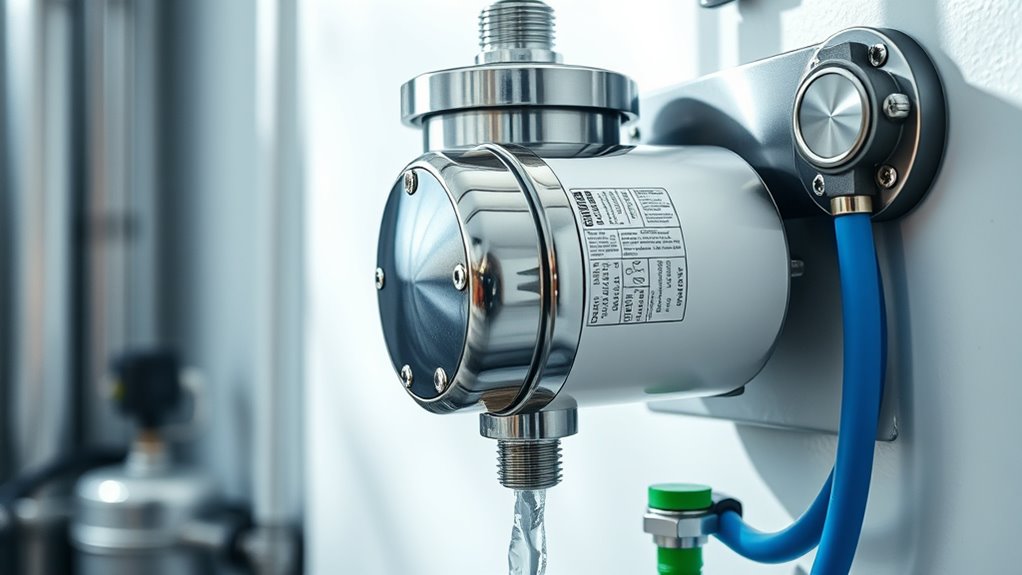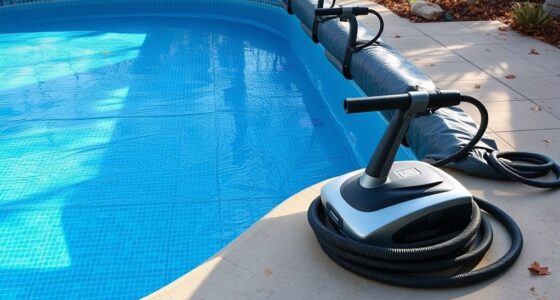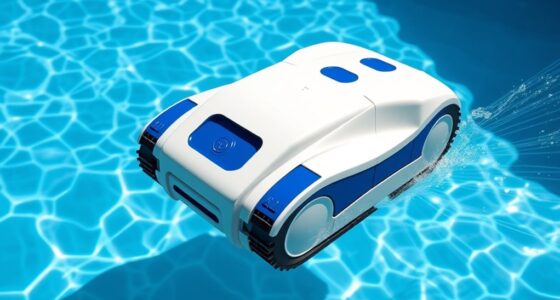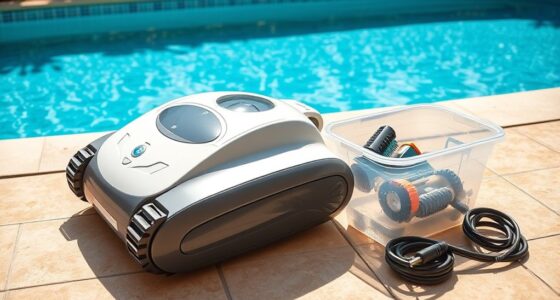If you notice weak water flow, low pressure during peak times, or your taps take longer to fill, a booster pump might be necessary. It works by increasing pressure and flow, especially in busy households or when multiple fixtures run at once. Before installing, consider your water needs, existing system, and possible alternatives like pipe upgrades. Want to find out more about how a booster pump can help your home? Keep exploring for details.
Key Takeaways
- Significant drops in water pressure or weak flow indicate a need for a booster pump.
- Household activities during peak times, like showers and laundry, may require additional water pressure.
- Signs such as increased energy consumption and pipe corrosion suggest the system is overworking without a booster.
- Properly sized booster pumps ensure consistent pressure during high demand, improving efficiency.
- Regularly inspecting your water system can help determine if a booster pump is necessary for optimal performance.
Signs That Indicate You Might Need a Booster Pump

If you notice that your water pressure has dropped considerably or water flow is weak, it could be a sign that you need a booster pump. Low pressure often leads to increased water usage, making it harder to conserve water effectively. You might find yourself running the tap longer or using more energy to get the desired flow. Additionally, weak flow can cause pipe corrosion over time, especially if pipes are forced to work harder to deliver water. A booster pump can help maintain consistent pressure, improving water efficiency and reducing strain on your plumbing. Properly maintaining your water system, including understanding the importance of pressure balance, is essential for optimal performance and longevity. Recognizing these signs early can save you money and extend your pipe’s lifespan. Regularly checking your water pressure levels can help prevent issues before they escalate. Ensuring your system has adequate filtration can also prevent debris buildup that may impact flow and pressure. Furthermore, maintaining proper pressure helps avoid pipe damage caused by fluctuations and pressure spikes.
Understanding How a Booster Pump Works

A booster pump works by actively increasing water pressure and flow to your household plumbing system. It does this through its pump mechanics, which involve a motor and impeller that work together to move water efficiently. When water pressure drops, the pump detects the decrease and activates, drawing water in from the main supply. The impeller then spins rapidly, creating centrifugal force that pushes water out at higher pressure. This process guarantees a steady water flow, even when your household demands more pressure. Understanding how the pump mechanics operate helps you see how a booster pump maintains consistent water flow, making daily tasks like showering, washing dishes, and watering your lawn more efficient and reliable. Additionally, pump efficiency plays a crucial role in ensuring the system consumes less energy while providing maximum performance. Proper maintenance of the pump components can further optimize system performance, ensuring longevity and reliable operation. Regularly inspecting and cleaning the pump components can prevent common issues and keep the system running smoothly, especially since component wear can lead to reduced efficiency over time. Incorporating preventive maintenance strategies can help extend the lifespan of your booster pump and improve its overall effectiveness.
Common Household Situations Requiring Extra Water Pressure

Certain household activities demand higher water pressure to function effectively, especially when multiple tasks occur simultaneously. For example, running the dishwasher, taking a shower, and watering the garden all require sufficient water pressure. If your water pressure drops during peak usage, a booster pump with adequate pump capacity can help maintain consistent flow. Consider these common situations:
| Activity | Water Pressure Needed | Pump Capacity Requirements |
|---|---|---|
| Showering and laundry | High | Moderate to high |
| Using multiple faucets | Moderate to high | Adequate for simultaneous use |
| Gardening with sprinklers | Moderate | Sufficient for even coverage |
Without enough pump capacity, water pressure drops, disrupting your household routines. A booster pump guarantees steady pressure during peak demands. Understanding water pressure systems can help you choose the right pump for your needs, especially when integrating pressure regulation to optimize performance. Additionally, ensuring proper installation and maintenance of your water system can prolong the lifespan of your pump and improve efficiency. Proper system design is crucial for achieving optimal water pressure levels throughout your home, especially when considering storage tank capacity to support consistent pressure during high demand periods.
Factors to Consider Before Installing a Booster Pump
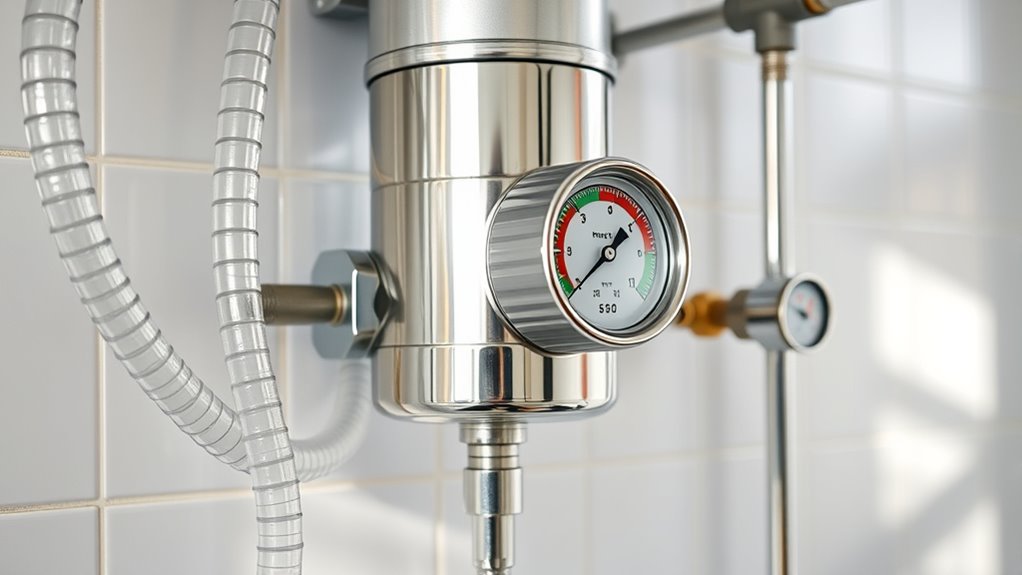
Before installing a booster pump, you should assess your household’s specific water needs and existing system capabilities. Consider how much water your household uses daily and whether your current setup can handle peak demands. Here are key factors to weigh:
- Water conservation: Will the pump help reduce unnecessary water waste? Understanding your current water usage patterns can help determine if a booster pump will contribute to conservation efforts. Additionally, evaluating how your system manages pressure fluctuations can provide insight into potential efficiency improvements. Monitoring system performance metrics can help identify if your current setup is operating optimally or if upgrades are necessary. Maintaining awareness of pressure levels within your plumbing system can prevent damage and ensure consistent water flow.
- Cost analysis: Is the investment justified by the benefits and savings?
- System compatibility: Confirm your plumbing can support the booster pump.
- Long-term needs: Will your water demands grow or change over time?
- Performance metrics: Understanding your system’s current performance metrics can help determine if a booster pump will improve efficiency. Additionally, keeping an eye on these metrics ensures that your system remains optimized over time. Regularly reviewing these factors can help you make informed decisions about upgrades and maintenance.
Types of Booster Pumps and Their Benefits
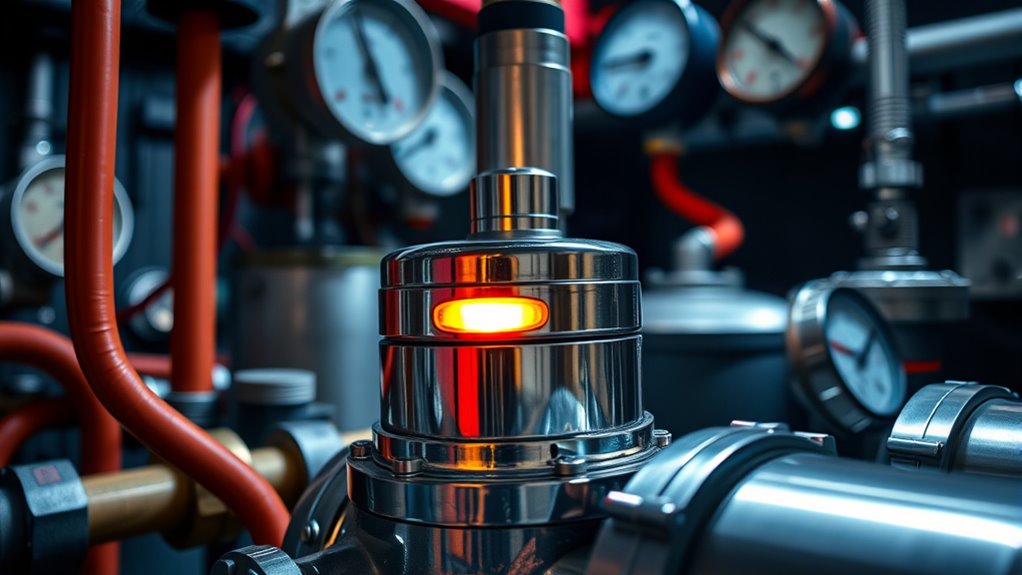
Choosing the right type of booster pump depends on your household’s specific water needs and system setup. For example, if you need to increase water pressure throughout your home, a centrifugal pump offers strong, steady flow, ideal for larger households. If your system requires precise control of water flow, a variable speed pump adjusts pump capacity to match demand, saving energy and reducing wear. For high-demand situations, a multi-stage pump increases capacity efficiently. Each pump type benefits different scenarios by enhancing water pressure and optimizing pump capacity, ensuring your system runs smoothly. Additionally, selecting a pump with proper sizing and installation is crucial for optimal performance and longevity. Proper head height and flow rate specifications are essential considerations for ensuring your pump functions effectively. Understanding these options helps you choose a booster pump that fits your household’s unique water requirements and protects your plumbing system. Proper pump maintenance further extends the lifespan and efficiency of your booster pump.
Installation and Maintenance Tips for Booster Pumps

Proper installation is key to ensuring your booster pump works efficiently and lasts longer. You should follow the manufacturer’s guidelines and double-check connections during setup. Regular maintenance, like inspecting for leaks and cleaning filters, helps keep your pump running smoothly. Incorporating routine inspections can prevent unexpected failures and extend the lifespan of your pump. Additionally, understanding best practices for maintenance can further improve performance and reliability. Using the appropriate Glycolic Acid concentrations in skincare routines can also contribute to healthier skin, which may indirectly support the overall functioning of your skin-related equipment. Implementing proper calibration procedures ensures your pump operates within optimal parameters, enhancing its longevity and efficiency.
Proper Installation Procedures
Ensuring correct installation is essential for your booster pump to operate efficiently and reliably. Proper setup affects water quality and energy efficiency, saving you money and preventing issues. To get it right, focus on these steps:
- Position the pump correctly—install it close to the water source for better performance.
- Secure proper piping connections—use durable, corrosion-resistant materials to maintain water quality.
- Ensure adequate power supply—verify voltage and grounding to prevent electrical issues.
- Check for proper venting and drainage—this keeps the pump cool and prevents water damage, ensuring consistent operation and energy efficiency.
Following these procedures helps your booster pump run smoothly, prolongs its lifespan, and maintains ideal water quality.
Routine Maintenance Tips
Regular maintenance is key to keeping your booster pump running efficiently and preventing unexpected failures. Start by inspecting the pump regularly for leaks or unusual noises, which could indicate a problem. Clean the pump’s filter to promote water conservation and guarantee peak performance. Check pipe insulation to prevent heat loss, especially in colder months, which can strain the pump and increase energy use. Lubricate moving parts as recommended by the manufacturer to reduce wear and tear. Keep the surrounding area clear of debris to allow proper ventilation. Regularly test the pressure switch to guarantee accurate operation. By staying proactive with these routine checks, you’ll extend your booster pump’s lifespan, save water, and maintain consistent water flow throughout your system.
Alternatives to Using a Booster Pump
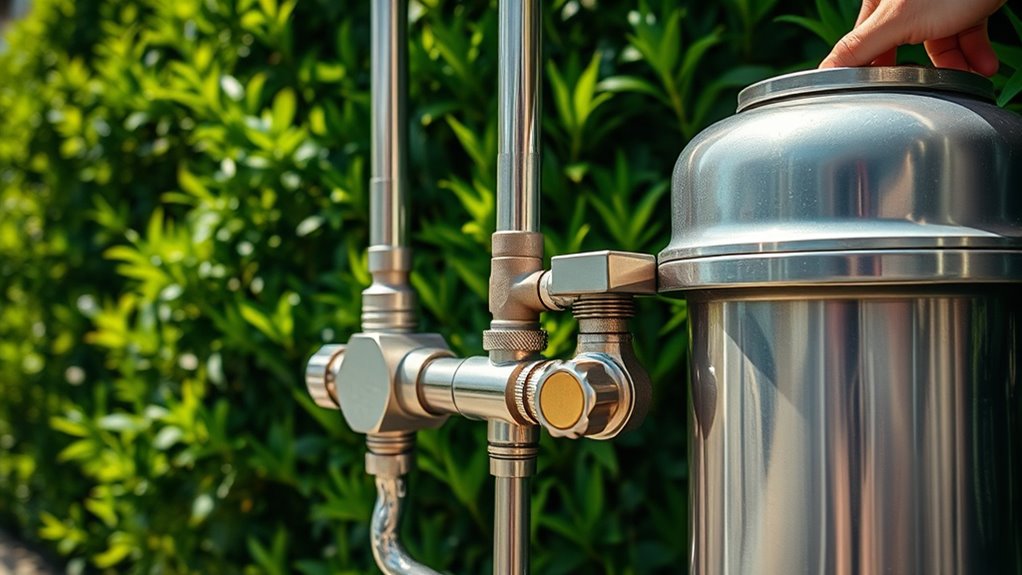
If you’re looking to avoid using a booster pump, there are several effective alternatives to contemplate. These options can help optimize your water system while promoting water conservation and reducing energy costs.
- Improve Pipe Insulation – Reducing leaks and friction loss keeps water pressure steady without extra equipment.
- Upgrade Your Plumbing – Installing larger pipes minimizes pressure drops, ensuring sufficient flow naturally.
- Adjust Water Pressure Settings – Lowering your main pressure can eliminate the need for a booster pump altogether.
- Use Alternative Solutions – Consider rainwater harvesting or gravity-fed systems that rely on natural water flow, enhancing water conservation while meeting your needs.
These alternatives can help you maintain adequate water pressure without constantly relying on a booster pump, saving energy and promoting a sustainable water system.
Frequently Asked Questions
How Much Does a Booster Pump Typically Cost to Install?
When considering the cost to install a booster pump, you’ll want a clear cost comparison to comprehend expenses. The installation process varies depending on your existing plumbing, but typically, it involves attaching the pump and ensuring proper wiring. Expect to pay between $500 and $1,500, including parts and labor. Keep in mind that professional installation ensures safety and efficiency, making the investment worthwhile for consistent water pressure.
Can a Booster Pump Increase Water Pressure for Multiple Fixtures?
Many believe a booster pump can boost water pressure for multiple fixtures, and research shows it’s true if the pump’s capacity matches your needs. A booster pump increases water pressure by adding force to the flow, effectively serving several fixtures simultaneously. However, if the pump’s capacity is too small, pressure won’t improve across all outlets. Make sure your pump is appropriately rated for your household’s water demand to achieve ideal results.
What Is the Average Lifespan of a Booster Pump?
The average lifespan of a booster pump typically ranges from 8 to 15 years. Regular pump maintenance, including checking for wear and tear, can extend this lifespan. Factors like water quality, usage frequency, and proper installation influence how long your pump lasts. To guarantee peak performance and longevity, keep up with routine maintenance and address issues promptly. Proper care helps your booster pump serve you reliably for many years.
Are There Any Safety Concerns With Using a Booster Pump?
Coincidentally, safety concerns with booster pumps mainly involve pump noise and electrical safety. You should check that your pump isn’t making excessive noise, which could indicate a malfunction. Always verify proper grounding and electrical connections to prevent shocks. Regular maintenance helps avoid issues, and following manufacturer instructions keeps you safe. If unsure, consult a professional to evaluate your setup, ensuring safe and efficient operation.
How Energy-Efficient Are Booster Pumps for Home Use?
Booster pumps are generally quite energy-efficient for home use, helping you maintain consistent water pressure while keeping energy consumption low. They typically have modern motor designs that reduce power usage, which can positively impact the environment by lowering your overall energy demand. When choosing a booster pump, look for models with energy-saving features to maximize efficiency and minimize environmental impact, saving you money and supporting sustainable living.
Conclusion
If you notice low water pressure affecting your daily routines, a booster pump could be the solution you need. It’s easy to overlook how much better your home feels with steady, powerful flow. Are you ready to enjoy consistent water pressure and eliminate those frustrating weak showers? Installing a booster pump can transform your household experience, making every tap turn a little more satisfying. Don’t wait—your perfect water flow is just a pump away.

